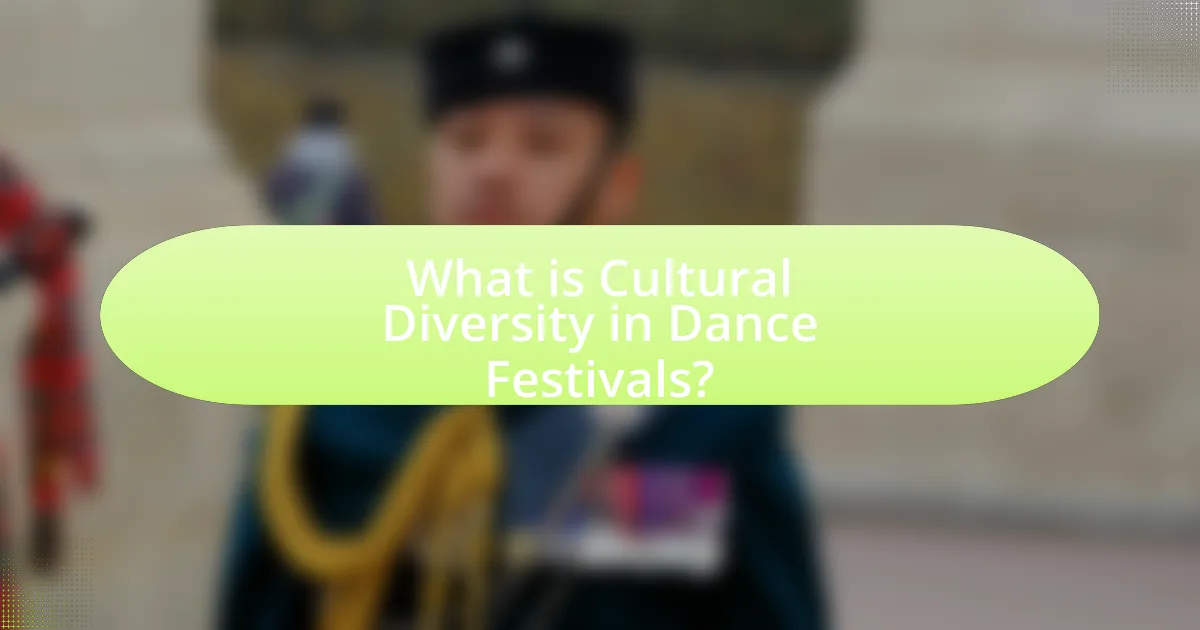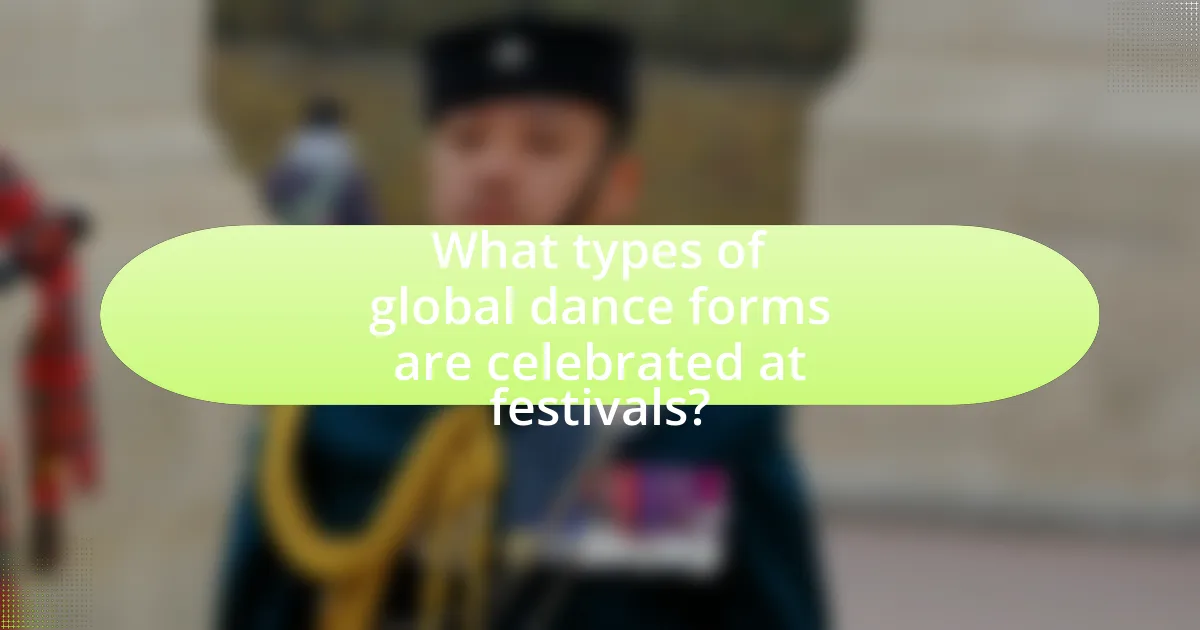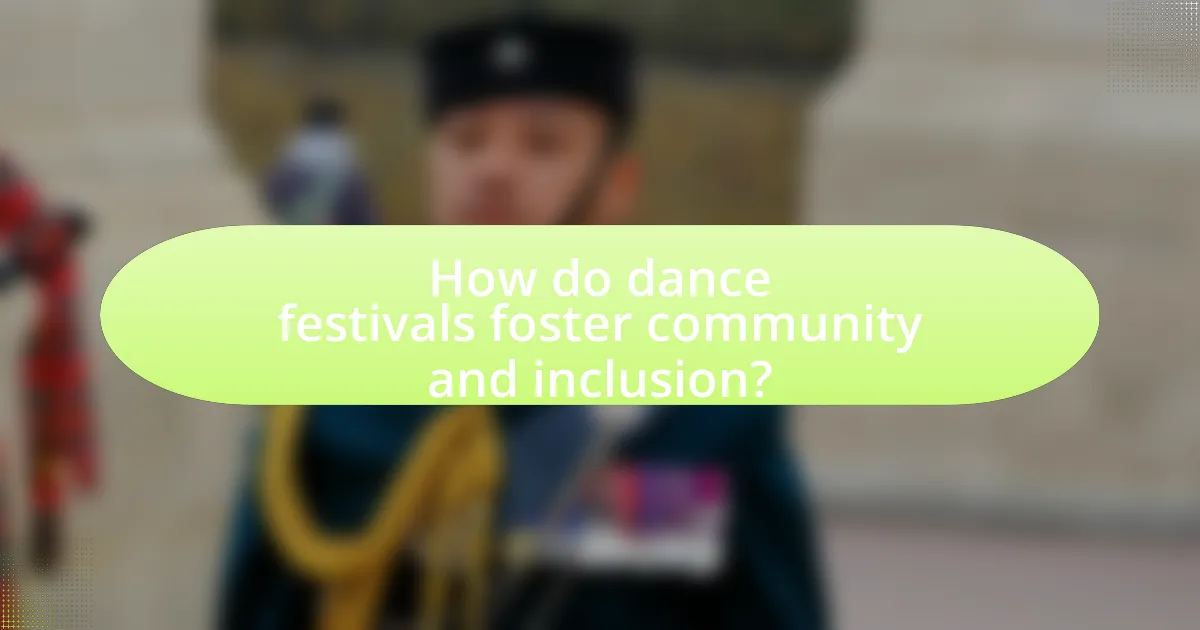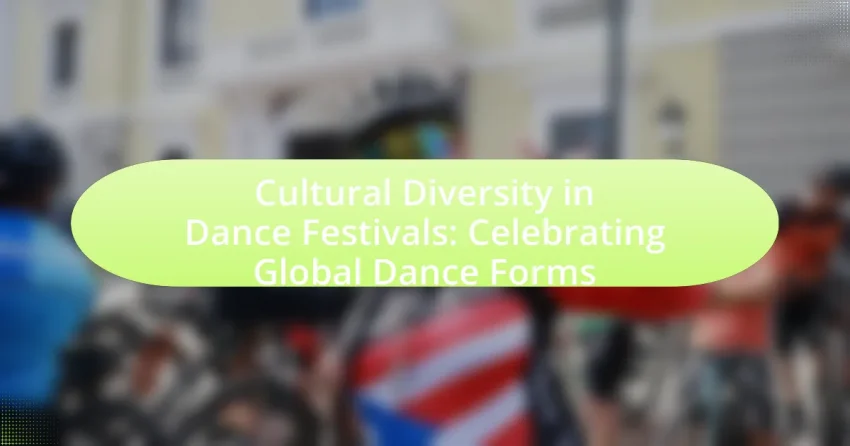Cultural diversity in dance festivals encompasses the representation of various cultural traditions, styles, and practices within dance performances, fostering cross-cultural understanding and appreciation. Festivals such as the Edinburgh Festival Fringe highlight a wide array of dance forms from around the world, showcasing traditional and contemporary styles that reflect the heritage of different communities. Key elements defining this diversity include unique movements, music, and costumes that convey cultural narratives. Dance festivals serve as vital platforms for preserving cultural heritage, promoting intercultural dialogue, and enhancing community engagement through workshops and performances, ultimately enriching the festival experience for both participants and audiences.

What is Cultural Diversity in Dance Festivals?
Cultural diversity in dance festivals refers to the inclusion and representation of various cultural traditions, styles, and practices within dance performances and events. This diversity showcases the rich tapestry of global dance forms, allowing audiences to experience and appreciate different cultural expressions. For instance, festivals like the Edinburgh Festival Fringe feature performances from diverse cultures, highlighting traditional dances from Africa, Asia, and Latin America, which fosters cross-cultural understanding and appreciation. Such representation not only enriches the festival experience but also promotes cultural exchange and dialogue among participants and audiences.
How does cultural diversity manifest in dance festivals?
Cultural diversity manifests in dance festivals through the inclusion of various dance styles, traditions, and performances that represent different cultural backgrounds. These festivals often feature a wide array of dance forms, such as African tribal dances, Indian classical dances, Latin salsa, and contemporary styles, showcasing the rich tapestry of global cultures. For instance, the Edinburgh Festival Fringe includes performances from over 50 countries, highlighting the significance of cultural exchange and appreciation. Additionally, dance festivals often incorporate traditional costumes, music, and storytelling elements that reflect the heritage of the participating cultures, further enriching the experience for audiences and performers alike.
What are the key elements that define cultural diversity in dance?
The key elements that define cultural diversity in dance include various styles, techniques, and cultural expressions that reflect the heritage and traditions of different communities. These elements encompass the unique movements, music, costumes, and narratives that are characteristic of specific cultures, such as African tribal dances, Indian classical forms, or Latin American folk dances. Each dance form serves as a medium for storytelling and cultural identity, showcasing the values, beliefs, and historical contexts of the communities from which they originate. For instance, the incorporation of traditional instruments and rhythms in these dances highlights the distinct musical influences that shape each cultural expression.
How do different cultures influence dance styles at festivals?
Different cultures significantly influence dance styles at festivals by incorporating unique movements, rhythms, and traditional attire that reflect their heritage. For instance, African dance often emphasizes community and storytelling through dynamic body movements and polyrhythmic drumming, while Indian classical dance forms like Bharatanatyam showcase intricate footwork and expressive hand gestures that convey specific narratives. Festivals such as Carnival in Brazil highlight samba, which blends African, Portuguese, and indigenous influences, creating a vibrant celebration of cultural fusion. This cultural exchange not only enriches the dance styles presented but also fosters a deeper appreciation for the diverse traditions that shape these performances.
Why are dance festivals important for cultural expression?
Dance festivals are important for cultural expression because they serve as platforms for showcasing diverse cultural identities and traditions through movement. These festivals allow communities to celebrate their heritage, share their stories, and foster intercultural dialogue. For instance, events like the Edinburgh Festival Fringe feature performances from various cultures, highlighting the significance of dance as a universal language that transcends barriers. Additionally, research indicates that participation in dance festivals can enhance cultural pride and community cohesion, reinforcing the role of dance in preserving and promoting cultural diversity.
What role do dance festivals play in preserving cultural heritage?
Dance festivals play a crucial role in preserving cultural heritage by providing a platform for traditional dance forms to be showcased and celebrated. These festivals often feature performances that reflect the history, values, and customs of specific communities, allowing for the transmission of cultural knowledge across generations. For instance, events like the Edinburgh Festival Fringe and the International Folk Festival in various countries highlight indigenous dances, ensuring that unique cultural expressions are not lost to modernization. Additionally, dance festivals foster community engagement and pride, as local participants and audiences connect with their cultural roots through shared experiences.
How do dance festivals promote intercultural dialogue?
Dance festivals promote intercultural dialogue by bringing together diverse cultural expressions through dance, allowing participants and audiences to engage with various traditions and practices. These festivals often feature performances from different countries, showcasing unique dance styles that reflect cultural histories and values. For instance, events like the Edinburgh Festival Fringe and the International Dance Festival Birmingham include artists from multiple backgrounds, facilitating interactions that foster understanding and appreciation of cultural differences. This exchange not only enhances cultural awareness but also encourages collaboration among artists, leading to innovative fusions of dance that further enrich the dialogue between cultures.

What types of global dance forms are celebrated at festivals?
Various global dance forms celebrated at festivals include traditional folk dances, contemporary dance styles, and cultural performance dances. Traditional folk dances, such as the Irish jig, Indian Bharatanatyam, and Brazilian samba, showcase the heritage and customs of specific regions. Contemporary dance styles, like hip-hop and modern dance, reflect current trends and social movements. Cultural performance dances, including the Maori haka and Spanish flamenco, highlight unique cultural narratives and artistic expressions. These dance forms are integral to festivals worldwide, promoting cultural exchange and appreciation.
How do traditional dance forms differ across cultures?
Traditional dance forms differ across cultures in their movements, music, costumes, and purposes. For instance, Indian classical dance emphasizes intricate footwork and hand gestures, reflecting spiritual themes, while African dance often features rhythmic body movements and communal participation, celebrating community and storytelling. Additionally, traditional Japanese dance, such as Kabuki, incorporates stylized movements and elaborate costumes to convey historical narratives. These differences are rooted in each culture’s history, values, and social structures, illustrating the diverse ways in which communities express identity and heritage through dance.
What are some examples of traditional dance forms from various regions?
Examples of traditional dance forms from various regions include Flamenco from Spain, Bharatanatyam from India, Hula from Hawaii, and Cossack dance from Ukraine. Flamenco, characterized by its passionate movements and intricate footwork, has roots in Andalusian culture and is recognized by UNESCO as an Intangible Cultural Heritage. Bharatanatyam, one of the oldest classical dance forms in India, combines expressive hand gestures and facial expressions to convey stories and emotions, with origins tracing back over 2,000 years. Hula, a Polynesian dance form, incorporates hip movements and gestures that tell stories, deeply connected to Hawaiian culture and spirituality. The Cossack dance, known for its energetic and acrobatic movements, reflects the traditions of the Cossack people in Ukraine and is often performed during celebrations and festivals. Each of these dance forms showcases the rich cultural heritage and diversity found in global dance traditions.
How do contemporary dance forms reflect cultural diversity?
Contemporary dance forms reflect cultural diversity by incorporating various cultural elements, styles, and techniques from around the world. This integration allows for a rich tapestry of movement that showcases the unique traditions, histories, and social contexts of different cultures. For instance, many contemporary choreographers draw inspiration from African, Asian, and Latin American dance forms, blending them with modern techniques to create innovative performances that celebrate multiculturalism. Research indicates that festivals featuring contemporary dance often highlight this diversity, showcasing works that represent a wide array of cultural backgrounds, thus fostering greater understanding and appreciation among audiences.
What are the most popular dance festivals around the world?
The most popular dance festivals around the world include the Rio Carnival in Brazil, the Edinburgh Festival Fringe in Scotland, and the Burning Man Festival in the United States. The Rio Carnival, celebrated annually, attracts millions of participants and spectators, showcasing samba and other Brazilian dance forms. The Edinburgh Festival Fringe, known for its diverse performances, features various dance styles and draws artists from around the globe. Burning Man, held in Nevada’s Black Rock Desert, emphasizes creativity and self-expression, including dance as a key component of its cultural experience. These festivals exemplify the global celebration of dance and cultural diversity.
What unique features do these festivals offer to celebrate cultural diversity?
Dance festivals celebrating cultural diversity offer unique features such as diverse performance styles, workshops, and cultural exchanges. These festivals showcase traditional and contemporary dance forms from various cultures, allowing attendees to experience a wide range of artistic expressions. For instance, festivals often include workshops led by international artists, providing participants with hands-on learning opportunities in different dance techniques. Additionally, cultural exchanges facilitate interactions between performers and audiences, fostering understanding and appreciation of different cultural backgrounds. Events like the Edinburgh Festival Fringe and the International Dance Festival Birmingham exemplify these features by presenting a multitude of global dance forms and encouraging cross-cultural dialogue.
How do these festivals attract international participation?
Dance festivals attract international participation through strategic marketing, cultural exchange programs, and collaborations with global artists. These festivals often utilize social media and targeted advertising to reach diverse audiences, showcasing their unique offerings and cultural significance. For instance, festivals like the Edinburgh Festival Fringe and the International Dance Festival Birmingham actively promote international acts, drawing performers and audiences from various countries. Additionally, partnerships with cultural institutions and sponsorships enhance visibility and accessibility, further encouraging global attendance.

How do dance festivals foster community and inclusion?
Dance festivals foster community and inclusion by bringing together diverse groups of people to celebrate cultural expressions through dance. These events create a shared space where individuals from various backgrounds can engage, collaborate, and learn from one another, promoting social cohesion. For instance, studies have shown that participation in community dance events enhances social bonds and reduces feelings of isolation, as seen in the 2018 research published in the Journal of Community Psychology, which highlighted how dance festivals encourage interaction among attendees, fostering a sense of belonging. Additionally, dance festivals often feature workshops and performances that showcase different cultural traditions, allowing participants to appreciate and respect diverse heritages, further reinforcing community ties and inclusivity.
What initiatives promote inclusivity in dance festivals?
Initiatives that promote inclusivity in dance festivals include accessibility programs, diverse programming, and community engagement efforts. Accessibility programs ensure that venues are equipped for individuals with disabilities, allowing them to participate fully in the festival experience. Diverse programming showcases a variety of dance styles from different cultures, ensuring representation and appreciation of global dance forms. Community engagement efforts involve collaboration with local artists and organizations to create a welcoming environment for all participants, fostering a sense of belonging. These initiatives are supported by research indicating that inclusive practices enhance audience engagement and participation, thereby enriching the cultural tapestry of dance festivals.
How do workshops and performances encourage community engagement?
Workshops and performances encourage community engagement by providing interactive platforms for individuals to participate in cultural expressions and shared experiences. These events foster social connections, as participants collaborate and communicate, enhancing a sense of belonging within the community. Research indicates that community-based workshops can increase social cohesion and cultural understanding, as seen in studies like “The Role of Arts in Community Development” by the National Endowment for the Arts, which highlights how arts initiatives promote civic engagement and community identity.
What impact do volunteer opportunities have on community involvement?
Volunteer opportunities significantly enhance community involvement by fostering social connections and encouraging civic engagement. When individuals participate in volunteer activities, they often develop a sense of belonging and responsibility towards their community. Research indicates that communities with active volunteer programs experience higher levels of social cohesion and trust among residents. For instance, a study by the Corporation for National and Community Service found that volunteers are more likely to engage in other forms of civic participation, such as voting and attending community meetings, thereby strengthening the overall fabric of the community.
How can attendees enhance their experience at dance festivals?
Attendees can enhance their experience at dance festivals by actively participating in workshops and engaging with performers. Participation in workshops allows attendees to learn new dance styles and techniques, fostering a deeper appreciation for the cultural diversity represented at the festival. Engaging with performers provides insights into the cultural significance of the dances, enriching the overall experience. Research indicates that interactive experiences at cultural events lead to higher satisfaction levels among attendees, as they feel more connected to the art forms being presented.
What tips can help festival-goers appreciate cultural diversity in dance?
Festival-goers can appreciate cultural diversity in dance by actively engaging with performers and learning about the origins and meanings of different dance styles. This engagement fosters a deeper understanding of the cultural contexts from which these dances emerge. For instance, attending workshops or discussions led by dancers can provide insights into the historical significance and techniques of various dance forms, such as African tribal dances or Indian classical dance. Additionally, observing the attire, music, and rhythms associated with each dance can enhance appreciation, as these elements often reflect the cultural heritage and values of the communities represented.
How can participants engage with performers and learn more about their cultures?
Participants can engage with performers and learn more about their cultures by attending workshops, participating in Q&A sessions, and observing live performances. Workshops provide hands-on experiences where participants can learn traditional dance techniques and cultural practices directly from the performers. Q&A sessions allow for direct interaction, enabling participants to ask questions about the cultural significance of the dances and the performers’ backgrounds. Observing live performances offers insights into the storytelling and cultural expressions inherent in the dances, enhancing understanding of the diverse cultural contexts.
